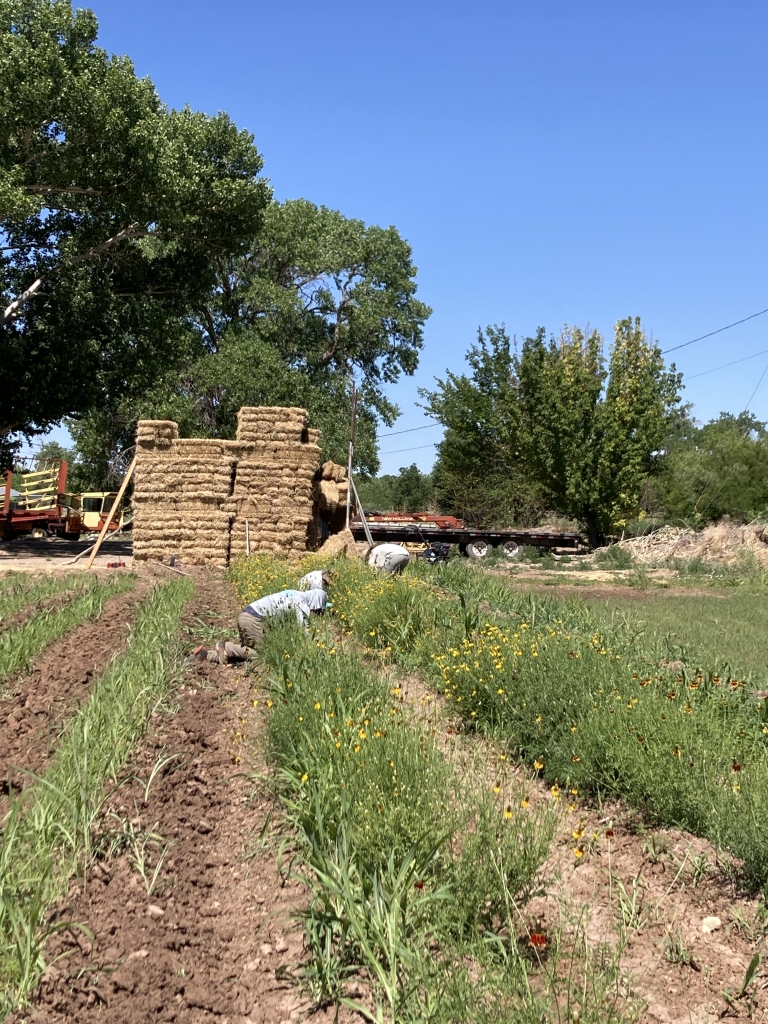By Violet Eklund, Travis Axtell, Hunter Brown, and Isaac Gonzales, September 2024
Hunter
This summer the Institute for Applied Ecology’s Southwest Office hosted a Youth Conservation Corps (YCC) crew of five members. The crew members are young professionals in the field of ecology learning various applications of ecological restoration and research. Each day brings something different – new challenges and new insights in nature.
Our days start around 7:30 am, when the crew meets up at the Santa Fe office to review the day’s plans or goals and gather the necessary gear. From here, the crew may head to National Forest lands between 30 minutes and 2 hours outside of Santa Fe to survey historic plant populations or search for and document new plant populations. All day or half of the day will be spent in the field, so lunch is usually brought along and enjoyed together at field sites. Some days and mornings consist of staff meetings, whether at the Southwest Office in Santa Fe, with both the Southwest and Northwest offices, or with various seed crews in Arizona and New Mexico. These meetings are incredibly important, as they allow this small community of earth-workers to share information, to support each other, to challenge each other, and promote growth. Our days consist of many different activities, but all of our work is earth-work, and all of our work is ecology applied.
Violet
Restoration work was one of my favorite projects of the summer. Admittedly, I expected our restoration days to feel long and uneventful, but I ended up looking forward to these calm days. The sites we visit on a regular basis are a satisfying way to see the impacts of our efforts in real time. Frequenting the same sites throughout our summer revealed that through our work, we make a gradual but certain impact on the ecosystems we have been working in. We visit our two main sites, Elk Mountain Farm and Leonora Curtin Wetland Preserve (LCWP), on a weekly to bi-weekly basis. At Elk Mountain, a native seed production farm at the Isleta Pueblo, we remove weeds from the cultivated plants and collect seeds when they are mature. At LCWP we remove invasives, broadcast native seed, and collect seed for future restoration. At both sites, these small acts gently persuade the native plants to flourish. By returning often, we experience the changes of the land through the many plant cycles embedded in one summer. We see plants through their stages of budding, flowering, and producing seed. We witness native plants expanding into the spaces we have cleared of invasives. The simple act of pulling weeds, although monotonous, is fruitful and rewarding. I am grateful for this experience and hope to do more restoration work in the future.

Isaac
Being able to work with the Institute for Applied Ecology has been one of the best work experiences I have ever had. Let me share a few of the memories I made with my team that highlighted the job for me! The very first time I ever went camping was with this team. I was super excited about this. As night came along, we all had dinner together and enjoyed each other’s company. It was awesome because people I’ve worked with in the past have been very reserved, but here it felt like each of my team members became part of a small family. My teammates would check on me to make sure I was drinking water and eating. Another great memory I have was going to the Native Plant Society conference in Taos. I had never been to a conference, and was a little unsure if I would come out learning anything new. I was completely shocked at how much I learned! It was awesome to be able to have an opportunity like this. It was also wonderful being able to travel with my team and bonding more with them was super amazing. All the laughs and joy that came with it wouldn’t have been possible without this job. I wouldn’t change a thing well. . . maybe one. . . MORE SNACKS!!!

Travis
Seeds are the foundation of IAE’s work; whether it’s scouting, collecting or dispersing seeds for restoration, there is no doubt they are essential to what we do. Personally, my favorite parts of this job all involved seeds. Scouting is the first step as well as my favorite, as we use existing data and locations to find and check on different species. This allows us to explore public lands as well as learn and identify more species. When the population is producing mature seeds we return and collect the seeds. This process includes estimating the population size and then collecting only a percentage of the available seed as to not negatively affect the population. After collection we then bring the seeds back to the office for cleaning. Collecting is a soothing and meditative process that is satisfying as you look back into your bag at the progress you’ve made. Finally comes seeding, a process in which you clear the debris from the area and then methodically spread seed on the ground, followed by mixing it into the soil. The process is systematic and fulfilling as you progress.
This summer has given us the opportunity to learn and work from professionals who care deeply about the earth. Even more importantly, we have learned applicable skills to do this work. In turn, we have learned directly from the earth. Each one of us is incredibly thankful for the experience, and grateful to all who have helped us along the way. In whatever ways we can, we hope to continue this good work, with good people. It is needed.

—
We would like to thank the Youth Conservation Corps and US Forest Service for sponsoring our work. We have found great value in this experience and see it as a stepping stone into our future careers.
